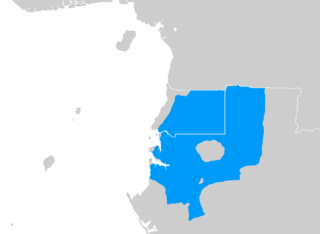Related Research Articles

Fang is a Central African language spoken by around 1 million people, most of them in Equatorial Guinea, and northern Gabon, where it is the dominant Bantu language; Fang is also spoken in southern Cameroon, the Republic of the Congo, and small fractions of the islands of São Tomé and Príncipe. It is related to the Bulu and Ewondo languages of southern Cameroon.
Basaa, or Mbene, is a Bantu language spoken in Cameroon by the Basaa people. It is spoken by about 300,000 people in the Centre and Littoral regions.
Bulu is a Bantu language of the Bulu people of Cameroon. The language had 174,000 native speakers in 1982, with some 800,000 second language speakers in 1991. Its dialects include Bene, Yelinda, Yembana, Yengono, and Zaman. Bulu was formerly used by colonial and missionary groups as a lingua franca in the region for commercial, educational, and religious purposes, though it is today becoming less frequent in those spheres.
The Nzime are a Bantu ethnic group inhabiting the rain forest zone of southeastern Cameroon. The Nzime live along the road running south of Abong-Mbang, through Mindourou and Lomié, and forking to Zoulabot and Zwadiba. Their territory lies south of the Koonzime in Djaposten, east of the Badwe'e, north of the Njyem, and west of the Konabembe people, all related groups. The Nzime speak the Nzime dialect of Koonzime ("OZM"), one of the Makaa–Njyem Bantu languages.
Kako is a Bantu language spoken mainly in Cameroon, with some speakers in the Central African Republic and the Republic of the Congo. The main population centres of Kako speakers are Batouri and Ndélélé in the East Region of Cameroon.
Mazagway is a Chadic language spoken in Cameroon, in North Province and Far North Province. Blench (2006) classifies it as a dialect of Daba.
Kol is a Niger–Congo language of the Bantu family, associated with the Bikélé ethnic group. It is spoken in the East Province of Cameroon, in the vicinity of Messaména. Alternate names for Kol language include Bikele-Bikay, Bikele-Bikeng, Bikélé, and Bekol.
Bankon is a Bantu language spoken in the Moungo department of the Littoral Province of southwestern Cameroon. It has a lexical similarity of 86% with Rombi which is spoken in the nearby Meme department of Southwest Province.

The Kwasio language, also known as Ngumba / Mvumbo, Bujeba, and Gyele / Kola, is a language of Cameroon, spoken in the south along the coast and at the border with Equatorial Guinea by some 70,000 members of the Ngumba, Kwasio, Gyele and Mabi peoples. Many authors view Kwasio and the Gyele/Kola language as distinct. In the Ethnologue, the languages therefore receive different codes: Kwasio has the ISO 639-3 code nmg, while Gyele has the code gyi. The Kwasio, Ngumba, and Mabi are village farmers; the Gyele are nomadic Pygmy hunter-gatherers living in the rain forest.
Kogo, also referred to as Bakoko and Basoo, is a Bantu language of Cameroon. North and South Kogo are as distinct from each other as they are from Basaa; they might be considered three dialects of a single language.
Musgu is a cluster of closely related language varieties of the Biu–Mandara subgroup of the Chadic languages spoken in Cameroon and Chad. The endonym is Mulwi. Blench (2006) classifies the three varieties as separate languages. Speakers of the extinct related language Muskum have switched to one of these.
Makaa (Maka), or South Makaa, is a Bantu language of Cameroon. It is not intelligible with the other language spoken by the Makaa people, North Makaa.
Pol is a Bantu language of Cameroon. Pol proper is spoken in central Cameroon; the Pomo and Kweso dialects are spoken in Congo and the CAR near the Cameroonian border.
Hdi is an Afro-Asiatic language of Cameroon and Nigeria.
Mpumpong (Mpongmpong) is a Bantu language of Cameroon. Maho (2009) considers Mpiemo to be a dialect.
Mono is a moribund Mbum language spoken by older adults in northern Cameroon.
Swo is a Bantu language of the Akonolinga area, Cameroon. Spellings of the name are quite variable, including So, Sso, Shwo, and Fo. One dialect has been influenced by Beti.
Bekwel (Bekwil) is a Bantu language of the Republic of the Congo. There are some 10,000 speakers there, with a quarter that number across the border in Gabon, and perhaps a similar on the opposite side in Cameroon. It is rather close to Nzime (Koonzime).
Bebil (Gbïgbïl) is a Bantu language of Cameroon. It is mutually intelligible with other Beti dialects.
Leti is a Bantu language of Cameroon, spoken by the Mengisa people. Most Mengisa have switched to the Eton language, though a number of them continue to use Leti as a secret ritual language. A smaller number speak Leti as their mother tongue.
References
- ↑ Nzime at Ethnologue (18th ed., 2015) (subscription required)
- ↑ Jouni Filip Maho, 2009. New Updated Guthrie List Online
- 1 2 3 Binam Bikoi, Charles, ed. (2012). Atlas linguistique du Cameroun (ALCAM)[Linguistic Atlas of Cameroon]. Atlas linguistique de l'Afrique centrale (ALAC) (in French). Vol. 1: Inventaire des langues. Yaoundé: CERDOTOLA. ISBN 9789956796069.